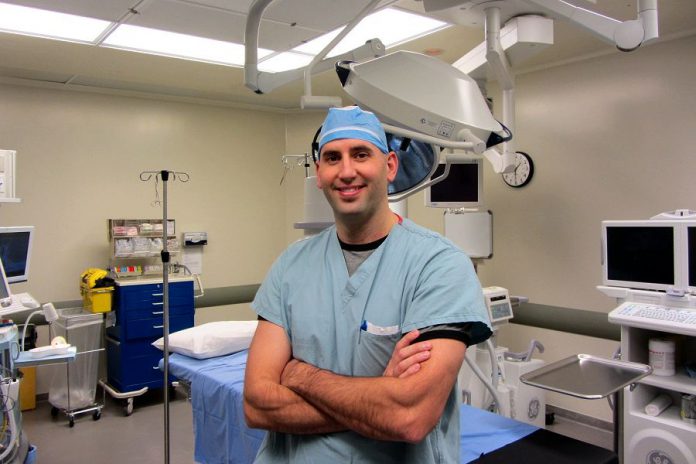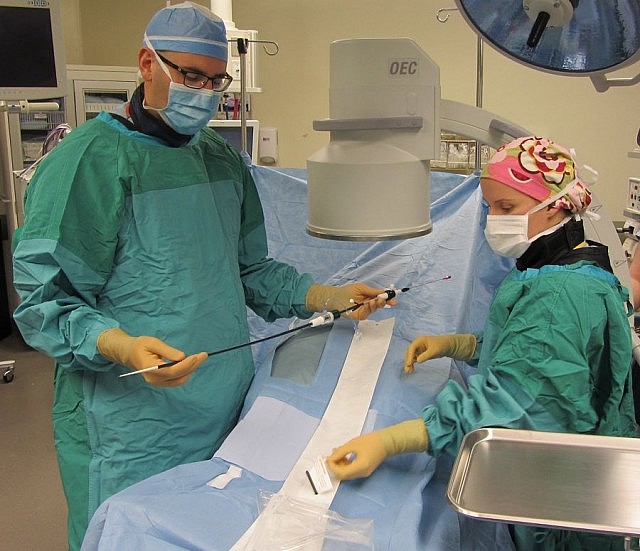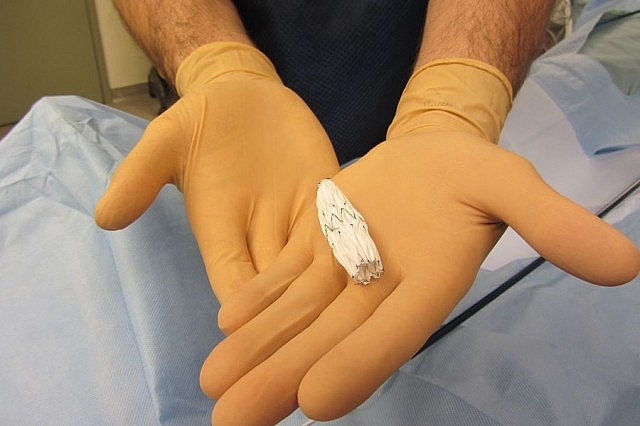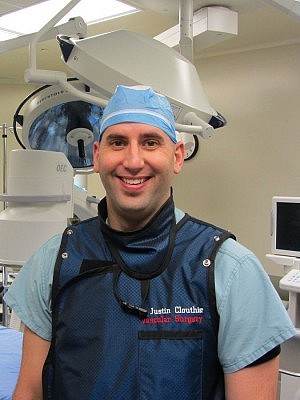
Dr. Justin Clouthier, a vascular surgeon at Peterborough Regional Health Centre (PRHC), is using a cutting-edge procedure to help save the lives of vulnerable patients who suffer from a potentially deadly condition. Without donations to the PRHC Foundation, the hospital wouldn’t have the equipment and tools it needs to support the life-saving therapy.
The technical term for the potentially deadly condition is abdominal aortic aneurysm, but vascular surgeons also call it “the silent killer.”
It’s a permanent weakening in a section of the abdominal aorta, the main artery that carries blood from the heart to the entire body. Over time, the weakened section expands like a balloon and can rupture without warning — causing massive internal bleeding that’s often fatal within minutes.
“Because there are few or no symptoms, people are unaware that they have it,” explains Dr. Clouthier. “But once it ruptures, the fatality rate is greater than 75 percent.”
As many as 3.3 million Canadians may have an abdominal aortic aneurysm and not realize it. While it’s twice as common in men than women, the risk of rupture is four times greater in women.
“Every man and woman over the age of 65 should have a screening ultrasound to detect these aneurysms,” Dr. Clouthier notes.
The hospital’s technologically advanced diagnostic imaging equipment, funded in part through donations to the PRHC Foundation, make the aneurysms much easier to detect. The good news is that, once detected, the majority of the aneurysms can be repaired surgically.
In the past, the only option available for repairing an abdominal aortic aneurysm was open surgery — which involves giving the patient a general anaesthetic, opening up the abdominal cavity, and operating directly on the abdominal aorta. For patients who are frail or who have pre-existing medical conditions, this kind of open surgery can be as potentially life threatening as the abdominal aortic aneurysm itself.
Fortunately, there is a cutting-edge therapy now available at PRHC for these patients: a minimally invasive procedure known as Endovascular Aneurysm Repair (EVAR). In this procedure, a surgeon makes two small incisions at the top of each leg in the groin area. Using a catheter threaded through the circulatory system, the surgeon maneuvers a fabric graft known as a stent into position in the abdominal aorta. Once in place, the metal struts are expanded, securing the graft and allowing blood to flow.

Thanks in part to donations to the PRHC Foundation, the hospital was able to introduce the EVAR procedure in 2012 and, in July 2013, recruited Dr. Clouthier as a third vascular surgeon to help tackle the increasing need for the minimally invasive procedure. The hospital’s goal is enhance patient care by increasing the percentage of abdominal aortic aneurysms repaired using EVAR instead of open surgery, for those patients for whom EVAR is the best option.
“I was recruited just after the hospital implemented EVAR,” Dr. Clouthier recalls. “Since that time, we’ve increased the percentage of endovascular procedures to 30 percent. We’re working toward a goal of 50 percent and to have the procedure offered to every patient. What’s key to our goal is making this procedure possible for patients who would otherwise not be able to tolerate any surgery.”
Dr. Clouthier received his medical education at the University of Ottawa and received further training in general and vascular surgery at McMaster University in Hamilton.
Just before joining PRHC, he received specialized training in endovascular surgery at Stanford University in California.
“EVAR is much less invasive than traditional surgery,” he says. “Because we make two small incisions to the groin area, it’s much faster and lower risk.”
While open surgery may still be the best option for some patients, EVAR can be a safer alternative for those who are frail or have a pre-existing medical condition. It takes less time and can be performed with just a local or spinal anaesthetic. It means shorter hospital stays, allowing patients to return to normal activities more quickly. Hospital stays are cut by more than five days on average when a patient undergoes EVAR versus the open repair method.
“It makes a huge difference,” Dr. Clouthier explains. “Patients recover much more quickly after the procedure. A typical patient will return home in one to two days, and be back to their regular life pretty quickly.”


Vascular surgeons are in very high demand across Canada, but Dr. Clouthier chose to relocate with his family to Peterborough so he could practice at PRHC. Part of the attraction was Peterborough itself, being close to both his hometown of Ottawa and cottage country, but more importantly it was PRHC’s reputation for exceptional care. He felt very welcomed by the PRHC community, and found the nursing staff support and equipment at the hospital excellent.
Dr. Clouthier also acknowledges how important community donations are in supporting his life-saving work.
“It’s the generous donations to the PRHC Foundation that allowed us to bring this cutting-edge therapy to Peterborough,” he says.
There are several ways you can donate to the PRHC Foundation, including a one-time donation, memorial giving, monthly giving, and more. Visit the PRHC Foundation website at www.prhcfoundation.ca to find out more.
All photos courtesy of the Peterborough Regional Health Centre Foundation.


























